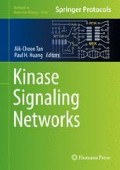Abstract
Kinases are involved in a broad spectrum of cell behaviors. A single kinase can interact with different ligands each eliciting a specific cellular response. Dissecting downstream signaling pathways of kinases is a key step to understanding physiological and pathological cell process. However, directing kinase activity to specific substrates remains challenging. Here, we present a new tool to selectively activate a kinase in a specific protein complex in living cells. This technology uses a rapamycin-inducible kinase activation coupled to interaction with FKBP12-binding domain (FRB) tagged protein. Here, we demonstrate application of this method by targeting Src to either p130Cas or FAK and discriminating cell mophodynamic changes downstream each of these signaling complexes.
Access this chapter
Tax calculation will be finalised at checkout
Purchases are for personal use only
References
Hunter T (1995) Protein kinases and phosphatases: the yin and yang of protein phosphorylation and signaling. Cell 80:225–236
Bishop AC, Shah K, Liu Y et al (1998) Design of allele-specific inhibitors to probe protein kinase signaling. Curr Biol 8:257–266
a Weiss W, Taylor SS, Shokat KM (2007) Recognizing and exploiting differences between RNAi and small-molecule inhibitors. Nat Chem Biol 3:739–744
Thomas SM, Brugge JS (1997) Cellular functions regulated by Src family kinases. Annu Rev Cell Dev Biol 13:513–609
Frame MC (2002) Src in cancer: deregulation and consequences for cell behaviour. Biochim Biophys Acta 1602:114–130
Playford MP, Schaller MD (2004) The interplay between Src and integrins in normal and tumor biology. Oncogene 23:7928–7946
Brown MT, Cooper JA (1996) Regulation, substrates and functions of src. Biochim Biophys Acta 1287:121–149
Karginov AV, Ding F, Kota P et al (2010) Engineered allosteric activation of kinases in living cells. Nat Biotechnol 28:743–747
Karginov AV, Hahn KM (2011) Allosteric activation of kinases: design and application of rapr kinases. Curr Protoc Cell Biol Chapter 14:Unit14.13
Karginov AV, Tsygankov D, Berginski M et al (2014) Dissecting motility signaling through activation of specific Src-effector complexes. Nat Chem Biol 10:286–290
Schaller MD, Hildebrand JD, Shannon JD et al (1994) Autophosphorylation of the focal adhesion kinase, pp125FAK, directs SH2-dependent binding of pp60src. Mol Cell Biol 14:1680–1688
Nakamoto T, Sakai R, Ozawa K et al (1996) Direct binding of C-terminal region of p130Cas to SH2 and SH3 domains of Src kinase. J Biol Chem 271:8959–8965
Sandhu GS, Precup W, Kline BC (1989) Rapid one-step characterization of recombinant vectors by direct analysis of transformed Escherichia coli colonies. BioTechniques 7:689–690
Tsygankov D, Bilancia CG, Vitriol EA et al (2014) CellGeo: a computational platform for the analysis of shape changes in cells with complex geometries. J Cell Biol 204:443–460
Berginski ME, Vitriol EA, Hahn KM et al (2011) High-resolution quantification of focal adhesion spatiotemporal dynamics in living cells. PLoS One 6:e22025
Acknowledgments
We would like to thank Dr. Klaus Hahn for his support and guidance in development of this method. This work was supported by NIH R21 RCA159179A grant and Chicago Biomedical Consortium Pilot Grant to Dr. A. Karginov.
Author information
Authors and Affiliations
Corresponding author
Editor information
Editors and Affiliations
Rights and permissions
Copyright information
© 2017 Springer Science+Business Media LLC
About this protocol
Cite this protocol
Ray, AM., Klomp, J.E., Collins, K.B., Karginov, A.V. (2017). Dissecting Kinase Effector Signaling Using the RapRTAP Methodology. In: Tan, AC., Huang, P. (eds) Kinase Signaling Networks. Methods in Molecular Biology, vol 1636. Humana Press, New York, NY. https://doi.org/10.1007/978-1-4939-7154-1_2
Download citation
DOI: https://doi.org/10.1007/978-1-4939-7154-1_2
Published:
Publisher Name: Humana Press, New York, NY
Print ISBN: 978-1-4939-7152-7
Online ISBN: 978-1-4939-7154-1
eBook Packages: Springer Protocols

